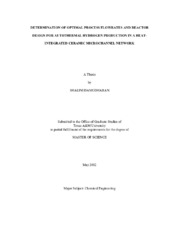| dc.description.abstract | The present work aimed at designing a thermally efficient microreactor system coupling methanol steam reforming with methanol combustion for autothermal hydrogen production. A preliminary study was performed by analyzing three prototype reactor
configurations to identify the optimal radial distribution pattern upon enhancing the
reactor self-insulation.
The annular heat integration pattern of Architecture C showed superior performance in providing efficient heat retention to the system with a 50 - 150 degrees C decrease in maximum external-surface temperature. Detailed work was performed using Architecture C configuration to optimize the catalyst placement in the microreactor network, and optimize reforming and combustion flows, using no third coolant line. The optimized combustion and reforming catalyst configuration prevented the hot-spot migration from the reactor midpoint and enabled stable reactor operation at all process flowrates studied. Best results were obtained at high reforming flowrates (1800 sccm) with an increase in combustion flowrate (300 sccm) with the net H2 yield of 53% and thermal efficiency of >80% from methanol with minimal insulation to the heatintegrated microchannel network.
The use of the third bank of channels for recuperative heat exchange by four different reactor configurations was explored to further enhance the reactor performance; the maximum overall hydrogen yield was increased to 58% by preheating the reforming stream in the outer 16 heat retention channels.
An initial 3-D COMSOL model of the 25-channeled heat-exchanger microreactor was developed to predict the reactor hotspot shape, location, optimum process flowrates and substrate thermal conductivity. This study indicated that low thermal conductivity materials (e.g. ceramics, glass) provides enhanced efficiencies than high conductivity materials (e.g. silicon, stainless steel), by maintaining substantial thermal gradients in the system through minimization of axial heat conduction.
Final summary of the study included the determination of system energy density; a gravimetric energy density of 169.34 Wh/kg and a volumetric energy density of 506.02
Wh/l were achieved from brass architectures for 10 hrs operation, which is higher than the energy density of Li-Ion batteries (120 Wh/kg and 350 Wh/l). Overall, this research successfully established the optimal process flowrates and reactor design to enhance the potential of a thermally-efficient heat-exchanger microchannel network for autothermal hydrogen production in portable applications. | en |


